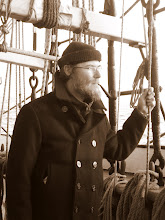(1853)
William Lewis Herndon was a professional naval officer in the US Navy during the first half of the 19th C.
He is mostly remembered as the captain of the SS Central America the famous "Ship of Gold" which sank in a hurricane of the coast of Cape Hatteras in 1857.
However his long and distinguished career in the Navy included one of the first source to mouth explorations of the Amazon river. Captain Herndon's report of his explorations in the Amazon was a best seller and immensely popular when it was first published in 1853. One young man was so inspired that he set out to travel down the Mississippi to try to get to the Amazon himself. There were no ships heading to Brazil from New Orleans so he stayed in the States changing his name from Samuel Clements to Mark Twain, the call of the men on the riverboats sounding the depths.
You can read a scanned copy of Captain Herndon's book here at the Internet Archive
Captain Herndon, although a US Navy officer, was in command of the SS Central America when she was lost in a hurricane in 1857, taking 423 men and many tons of gold to the bottom of the Atlantic along with her.
He was widely honoured for his heroic attempts to save his ship before loosing his life when she finally foundered after 3 days of pounding in the hurricane.
From Wikipedia
Herndon was carrying perhaps 15 tons of gold (then worth $2,000,000) and 474 passengers, many of whom were from California and were returning to the East Coast, as well as 101 crew members. After leaving Cuba on 7 September 1857, a few days later, they encountered a three-day hurricane off Cape Hatteras. The hurricane steadily increased in force. By the 12th, the Central America was shipping water through several leaks due to the ship's lack of water-tight bulkheads and general unseaworthiness. Water in her hold put out her boiler fires, precluding the use of steam for both controlling the ship and pumping out the bilges.
Herndon recognized that his ship was doomed; he flew its flag upside down as a distress signal and hoped another ship would see them. At 2 p.m., the West Indian brig Marine arrived to help take passengers from the stricken steamer. It did not have room to take on all of the passengers and crew. Commander Herndon supervised the difficult loading of women and children into lifeboats to transfer to the Marine. He gave one of the women passengers his watch to send to his wife, saying that he could not leave the ship while there was a soul on board. Most of the women and children reached safety on the Marine. Herndon's concern for his passengers and crew helped save 152 of the 575 people on board.
Men on the Central America tried to break up wooden parts to use as floats, in hopes of surviving the sinking. Some were rescued later by passing vessels, but most of the 423 persons on board died in what was the largest loss of life for a commercial ship in United States history. Survivors of the disaster reported last seeing Commander Herndon in full uniform, standing by the wheelhouse with his hand on the rail, hat off and in his hand, with his head bowed in prayer as the ship gave a lurch and went down.
The ship disaster and loss of so much gold, which banks still depended on, contributed to the financial Panic of 1857 in the United States.
The wreckage of the ship was discovered in a 1987 treasure recovery expedition.
The story of the Central America and the search for her is chronicled in a book "Ship of Gold" by Gary Kinder and will be the subject of another post. Stay tuned.
Keep your sightglass full your firebox trimmed and your water iced.
KJ




~ 0 comments: ~
~ Post a Comment ~